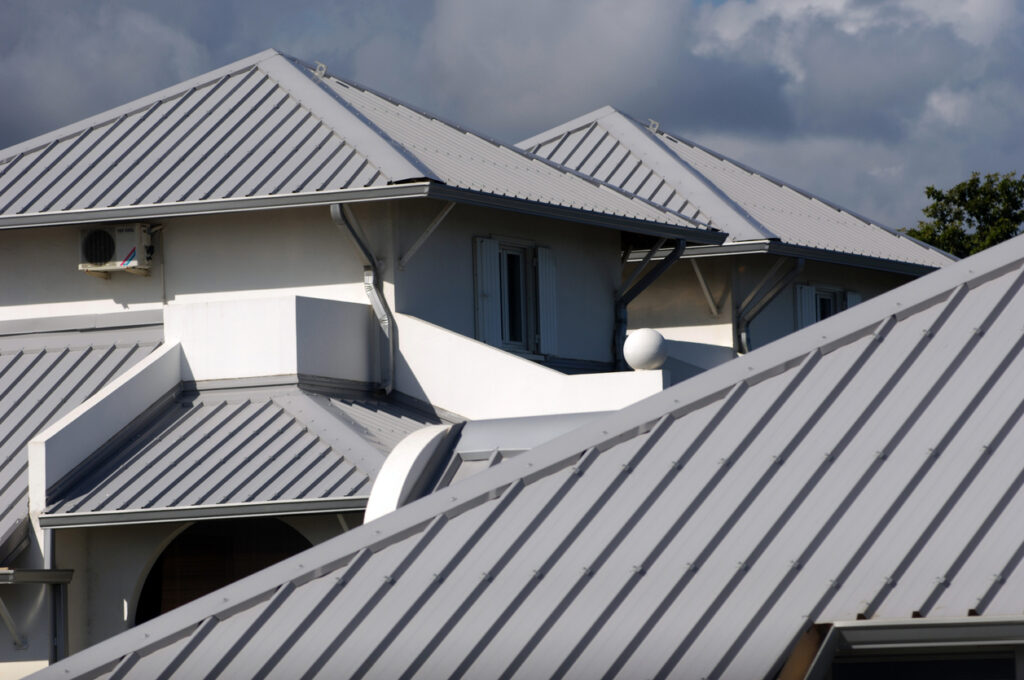
Imagine stepping outside on a hot summer day and choosing between a white and black T-shirt. Chances are you pick the white T-shirt, guessing it will reflect more sunlight and absorb less heat. Now, think of your roof as that T-shirt. A cool roof works in much the same way, reflecting sunlight and efficiently releasing any heat it does absorb, keeping the roof — and your building — significantly cooler. Just as fabric type, fit, and airflow influence how cool you stay in a T-shirt, the materials used in your roof play a crucial role in its ability to maintain a cooler temperature.
Whether you’re looking to reduce energy costs, boost comfort, or help cool down an urban heat island, a cool roof is one seriously cool choice. It is a smart, sustainable option, and research shows that a metal roof can keep your home cooler than traditional materials like asphalt. Let’s dive into understanding how a cool roof works, the best coatings, the benefits, and when a cool roof should be installed.
What Is a Cool Roof and How Does it Work?
A cool roof is designed to reflect more sunlight and release more heat than a standard roof. This means the roof itself stays cooler, which helps reduce the amount of heat that seeps into the building below. This can lead to a more stable and comfortable indoor temperature, especially for buildings without air conditioning. For those with air conditioning, a cool roof takes some of the strain off your cooling system, potentially lowering energy costs.
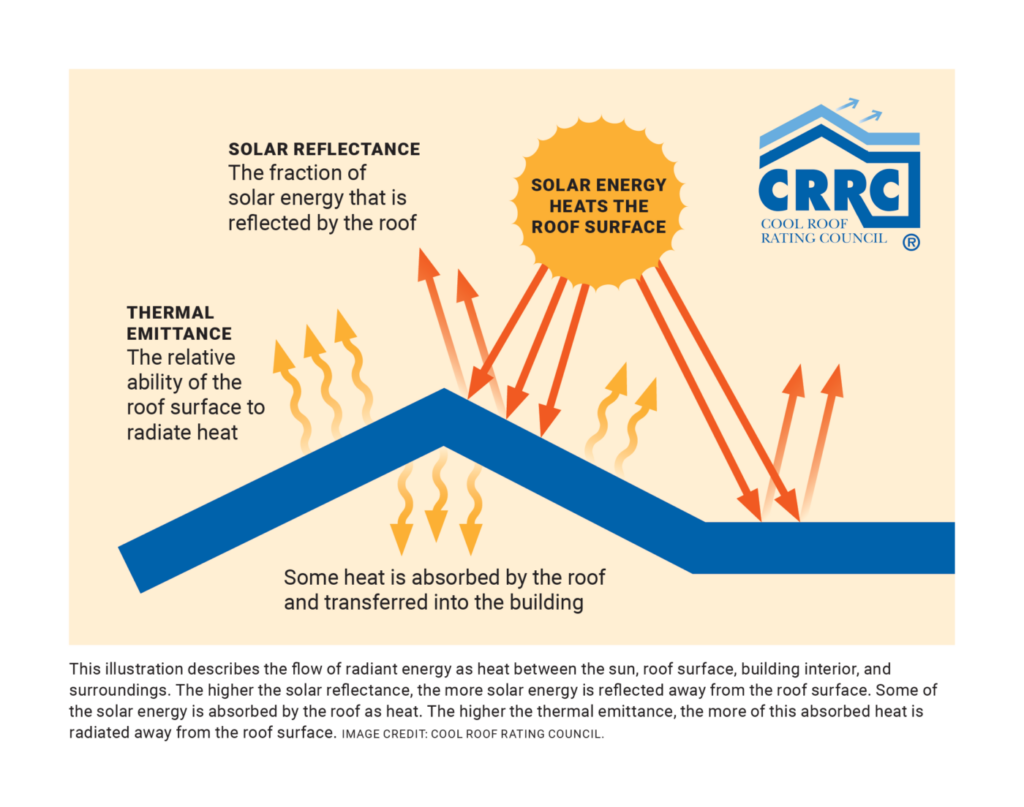
According to the Metal Roofing Alliance, “The secret to metal roofing’s energy savings is its variety of finishes. The basic, unpainted metal roof will reflect more solar radiation than an asphalt roof, which absorbs and holds heat. For homes in warmer climates, pre-painted or granular coated metal roofing systems reflect solar energy and cool your home by re-emitting most of what solar radiation is absorbed. A highly reflective and highly emissive painted or granular-coated metal roof is optimal for reducing energy consumption and can actually re-emit up to 90% of absorbed solar radiation.”
The “coolness” of a roof is determined by two key properties: solar reflectance and thermal emittance. These are measured on a scale from 0 to 1, where 1 represents maximum reflectivity or emittance. The higher these numbers, the cooler your roof will be.
Types of Cool Roof Coatings
Cool roof coatings can be added to most roofs and are applied similarly to paint on top of the already existing roof. Several types of cool roof coatings exist, with both acrylic and polyurethane systems offering effective cooling techniques.
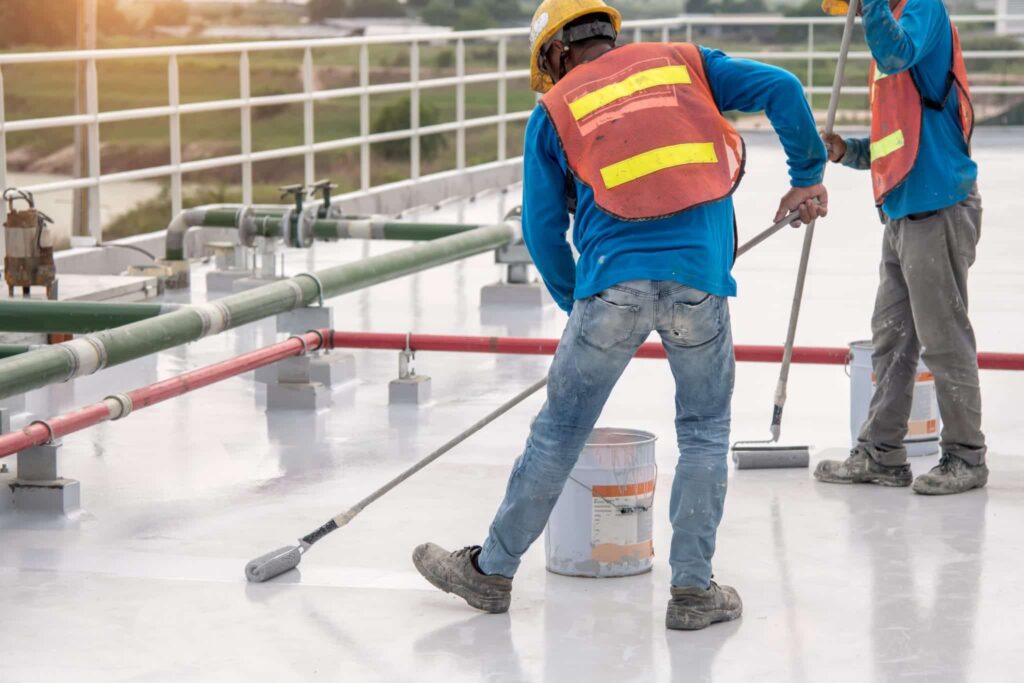
Acrylic Coatings
Acrylic coatings, frequently used on metal roofs due to its UV resistance, flexibility, and reflective properties, are water-based. Ideal for sloped metal and single-ply roofs, acrylics provide excellent reflectivity, helping to reduce heat absorption and can extend the roof’s lifespan. However, they are less effective in areas with frequent ponding water, as they can deteriorate over time.
Silicone Coatings
Often applied to metal roofs, silicone coatings are moisture-cured and highly resistant to UV exposure and water. They perform well in regions with heavy rain or ponding water, making them ideal for flat or low-slope roofs. Silicones offer long-lasting durability but tend to attract dirt, which can reduce their reflectivity over time.
Polyurethane Coatings
Polyurethane coatings are solvent-based and known for their impact and chemical resistance. They come in two types: aliphatic and aromatic. Aliphatic polyurethane is UV-stable and retains color better, making it ideal for topcoats. Aromatic polyurethane is less UV-resistant but more cost-effective, making it suitable as a base coat. Suitable for metal roofs, polyurethane is particularly useful in areas where impact resistance (e.g., from hail) is important.
Asphalt-Based Coatings
Asphalt-based coatings, or reflective or aluminized coatings, contain aluminum particles that enhance reflectivity. Rarely used on a metal roof, these coatings are more common on built-up roofing (BUR) or modified bitumen systems. While cost-effective, they are less reflective than other cool roof coatings and may degrade faster under UV exposure.
Fluoropolymer Coatings
Fluoropolymer coatings offer exceptional weather resistance and color retention. These coatings are frequently used on metal roofs, especially in commercial and architectural applications. Their superior weather resistance and color retention make them a popular choice for long-term protection. They are commonly used on metal roofs and architectural surfaces due to their durability and long-term reflectivity. Though highly effective, they are more expensive than other coatings.
Hybrid Coatings
Hybrid coatings combine the properties of two or more coating types, offering enhanced performance. For example, an acrylic-silicone hybrid can deliver both UV resistance and water repellency. Hybrid coatings are becoming increasingly popular for their versatility and durability. They are increasingly used on metal roofs, as they combine the benefits of different coating types, such as UV resistance and water repellency, making them versatile and effective.
Understanding Energy Efficiency in Cool Roofing
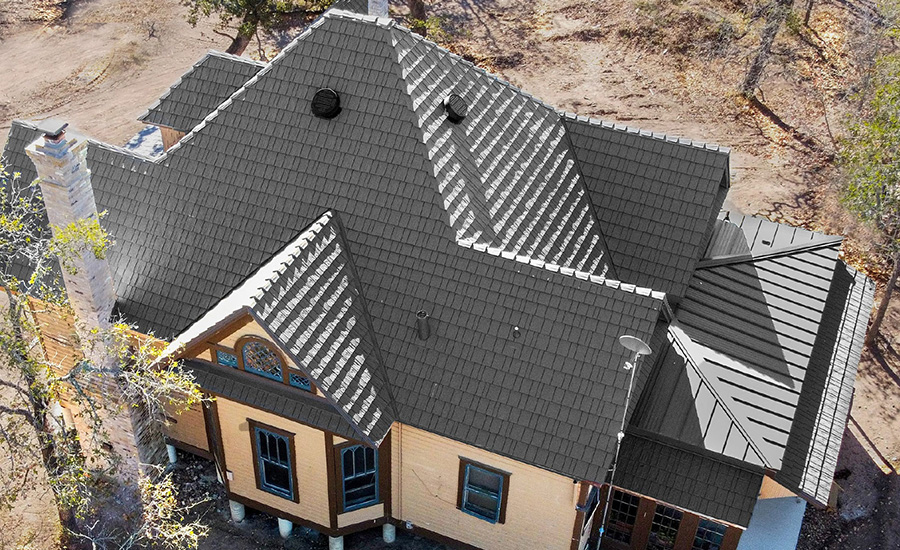
Metal roofs often perform better as cool roofs compared to other roofing materials due to their natural properties and the ability to be coated with reflective finishes. Here’s why:
- High Reflectivity: Metal roofs can be manufactured with highly reflective surfaces or coated with reflective paints, effectively bouncing off a significant portion of the sun’s rays, reducing the amount of heat absorbed. Standard roofs can reach temperatures of 150°F or higher on a hot day, while Cool roofs can be 50°F cooler, significantly lowering indoor temperatures.
- Thermal Emittance: Metal roofs also have good thermal emittance properties, meaning they can efficiently release the heat they do absorb, helping to keep the roof — and the building underneath — cooler. Buildings with cool roofs can experience 10% to 30% reductions in cooling energy use, especially in warmer climates. In large commercial buildings, for example, this can lead to thousands of dollars in annual energy savings.
- Durability: Metal roofs are long-lasting and resistant to degradation from weather exposure, which means their cool roof properties can last longer compared to some other materials that might degrade more quickly under harsh sunlight.
- Cool Color Options: Metal roofs are available in a wide range of colors, including “cool colors” that offer the reflective benefits of a cool roof while still allowing for aesthetic flexibility.
- Sustainability: Metal roofing systems contain 30-60 percent recycled content and last two to three times longer than other roofing materials, supporting sustainable construction in ways beyond cool roof ratings.
According to the Cool Roof Rating Council (CRRC), a nonprofit organization established in 1998 to develop accurate and credible methods for evaluating and labeling the solar reflectance and thermal emittance of roofing products, metal roofing products comprise nearly half of the over 3,000 rated products on the CRRC Rated Roof Products Directory. By maintaining a comprehensive database of rated products, the CRRC promotes the adoption of cool roofs, which contribute to energy savings, improved indoor comfort, and the reduction of urban heat islands. Through its rigorous testing standards and commitment to transparency, the CRRC plays a crucial role in advancing the use of sustainable roofing solutions.
Benefits of a Cool Roof
Choosing a cool roof comes with a range of advantages that go beyond simply keeping your building cooler. According to the CRRC, here are some key benefits to consider:
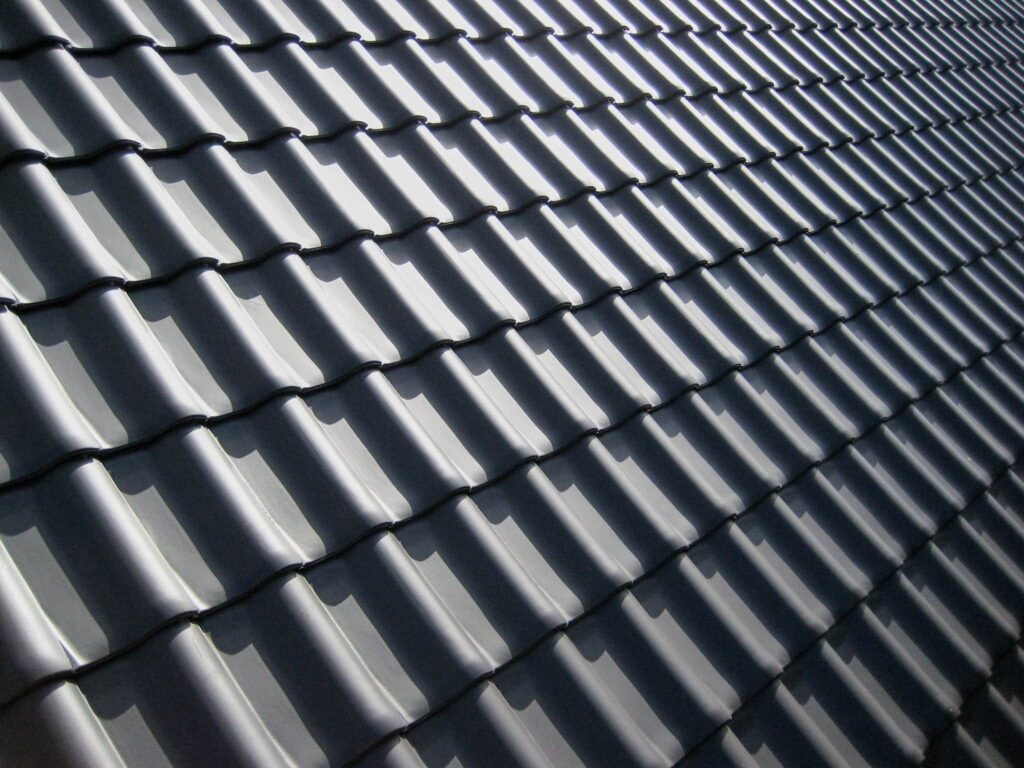
- Increases occupant comfort by keeping the building cooler during hot summer months.
- Reduces costs by reducing the need for air-conditioning and extending the life of cooling equipment; individual results vary based on a variety of factors related to the climate and installation.
- Decreases roof temperature, which may extend roof service life.
- Lowers air pollution and global warming concerns by lowering CO2 and other emissions associated with fossil fuel-generated electricity used for air-conditioning.
- Reduces the urban heat island effect by reflecting heat back to the atmosphere.
- Helps with local code compliance for building codes that have cool roof requirements.
Common Cool Roof FAQs
Does a cool roof really work?
Yes, cool roofs are effective at reducing heat absorption by reflecting more sunlight and emitting heat more efficiently than traditional roofs. According to the U.S. Department of Energy, a cool roof can lower roof surface temperatures by up to 50°F (28°C), reducing the amount of heat transferred into the building. This can lead to lower indoor temperatures and decreased reliance on air conditioning, especially in warmer climates.
How much can a cool roof save?
The energy savings from a cool roof depend on factors like climate, building type, and insulation. On average, cool roofs can reduce cooling costs by 10% to 30%. In hot climates, the savings can be even greater. Additionally, cool roofs can extend the lifespan of roofing materials by reducing thermal stress, leading to fewer repairs and replacements over time.
How long does a cool roof last?
The lifespan of a cool roof depends on the coating type and quality of installation. On average:
- Acrylic and silicone coatings last 10 to 20 years with proper maintenance.
- Fluoropolymer coatings can last 20+ years, offering superior durability.
- Polyurethane coatings typically last 15 to 25 years, with aliphatic polyurethane offering better UV resistance.
- Regular maintenance, such as cleaning and recoating, can extend the lifespan.
How much does a cool roof cost?
The cost of a cool roof varies based on the coating type, roof size, and installation complexity. On average:
- Cool roof coatings range from $0.75 to $3.00 per square foot, including labor.
- Cool roofing materials (e.g., reflective shingles or metal panels) cost $4 to $10 per square foot installed.
- While cool roofs have a higher upfront cost, the energy savings and extended roof life can provide a return on investment (ROI) within 5 to 10 years.
Where are cool roofs being used?
Cool roofs are increasingly used in hot and sunny regions where reducing heat gain is most beneficial. Common locations include:
- Southern and Southwestern U.S. (e.g., California, Arizona, Texas), where building codes encourage or require cool roofing.
- Urban areas where cool roofs help reduce the urban heat island effect.
- Commercial and industrial buildings seeking energy efficiency and sustainability certifications (e.g., LEED).
- Residential properties in warm climates aiming to reduce cooling costs.
Cool roofs are also being adopted in green building projects globally, including parts of Europe, Australia, and Asia.
Learn More with METALCON
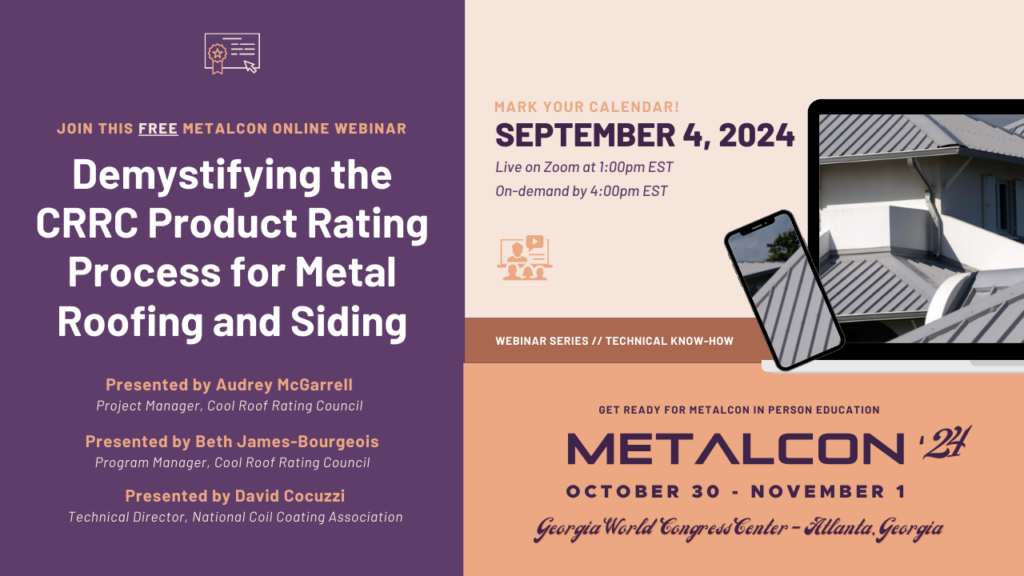
Learn more about the CRRC Product Rating Process for Metal Roofing with CRRC Program Managers Beth James-Bourgeois and Audrey McGarrell and David Cocuzzi, Technical Director of the National Coil Coating Association. Watch this FREE METALCON Online webinar on-demand for a deep dive into navigating the rating process focusing on CRRC’s Roof and Wall Color Family Programs, Reference Rating option, and the roles coating manufacturers, coil coaters, and fabricators play in the rating process.
Attend METALCON 2025! Learn firsthand about the effectiveness of cool roofs from industry experts and see the latest innovations directly from the manufacturers driving this technology forward. Whether you’re looking to improve energy efficiency, reduce cooling costs, or meet sustainability goals, METALCON offers a unique opportunity to explore cutting-edge products, attend educational sessions, and network with leading professionals shaping the future of metal construction. Don’t miss this chance to stay ahead of industry trends and discover how cool roofing can benefit your next project.
GET UPDATES ON METALCON 2025 HERE.
